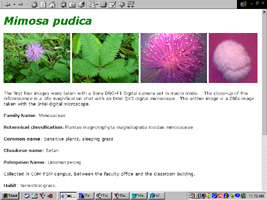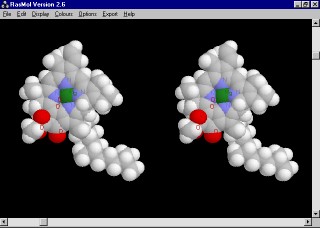
Traditionally, in botany courses, students prepare herbarium pages containing a plant specimen. The page is handed in to the instructor, graded, and then either handed back or discarded. The page typically has no life beyond the duration and confines of the botany course. The page is homework to be done by the student, a paper to be graded by the instructor, and forgotten by both shortly after the conclusion of the course.
In the Botany course at the College of Micronesia-FSM the students used the computer, a scanner, and digital cameras to create virtual herbarium pages which were placed on the College of Micronesia-FSM web server. These pages are accessible from around the world. Although only in place for a year and half, botanists and gardeners from around the globe have corresponded in regards information contained in the herbarium. These pages have a life beyond the duration and confines of the course. Many students sense this and attach an importance to the web pages beyond that of a mere classroom homework assignment. Students have also reported that this activity has made the course much more exciting and has made botany itself a more interesting subject.
In the Weather and Climate course the College web server was used both for course support and as a repository for images of local weather. Cloud images dominate the repository.
The students in the course were also each assigned a city for which they had to track the weather throughout the term. The students were required to use the Internet at least once a week to obtain the temperature in their city, the humidity, the dewpoint, the winds, and the barometric pressure. During the course of the term students periodically gave reports on the weather conditions for their city. In this activity the Internet permitted the Pacific Island students in the course a chance to learn more about the weather patterns of a distant and unknown place.
In Physical Science the obvious approach of using the computer to handle photogate timing, graphing, and other microcomputer based laboratory tasks was not taken. The reason is that the largest employer that offers a regular salary in the home villages of our students is the local school. As a result, many of our students are teachers at some point in their lives. The local schools do not have computers. If the only laboratories these teachers have experienced while they were in school utilizes advanced computer equipment, then these teachers will likely opt not to teach science. They will feel they do not have the necessary tools.
Physical science in particular lends itself to a low technology approach. With just a digital watch with a chronometer, a measuring tape or ruler, and a golf ball whole laboratories on linear motion and acceleration can be done. Other mechanics laboratories such as pendulum laboratories can be done with yarn, rocks, and a watch that can time seconds. Where equipment was needed, equipment was purchased from the local hardware store and involved commonly available materials. Thus linear expansion was done using ubiquitous PVC pipe.
Graph paper, nonexistant in the local schools, can be improvised using two sheets of notebook paper, one turned at ninety degrees and placed under the other one.
This was the approach experimented with in the Spring of 2000. The laboratories that were designed were made available at the College itself via the Internet.
One laboratory was done using the computer and depended exclusively on access to a computer. In this laboratory students explored the results of mixing different colors of light. Students manipulated the phosphors on a computer monitor using HyperText MarkUp Language (HTML). Although most of the students had used the Internet for Internet based email, none had prior contact with web page tags. Although only a minimalist contact, this laboratory introduced the world behind the web page. The laboratory also introduced the idea of having to work in another mathematical base as the colors of the monitor are controlled by a hexadecimal code when operated from HTML.
Other laboratory courses do not lend themselves quite so readily to a low technology, low cost approach. Biology requires microscopes, rarely available in the rural schools. Chemistry beyond simple kitchen experiments requires chemicals, glassware, and bunsen burners, non-existent in the rural schools. Hence the brunt of the load of introducing low technology, low cost laboratories to the students must fall to courses such as physical science.
Chemistry is a course few students at the College take and those who take the course find it to be rather daunting and difficult. The instructor in the course requested Computer Aided Instructional support that was tied directly to the textbook. In this case a CDROM/textbook combination was found and adopted. The CDROM is more directly tutorial support than a use as a tool. One facet of the software is worth mentioning. The software includes a library of 3-dimesional chemical models including stereoscopic presentation capabilities. Students can freely rotate the chemical models, and with some training see 3-dimensional views of the molecules. This capability is not possible without the computer.
